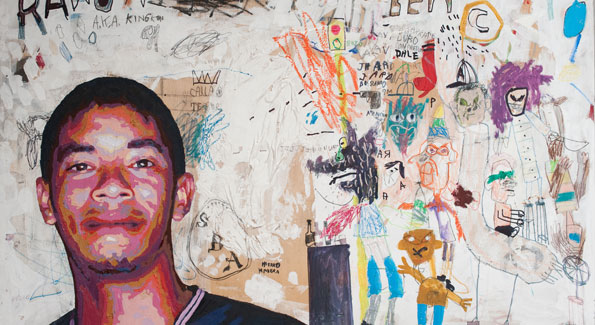Transformer offers up-close look at Washingtonians’ art collections.
By Anne Kim-Dannibale

“Ramon” mixed media on wood 2008 by Aaron Lopez is part of one collection featured in this year’s Transformer Collector’s View. (Photo by Joseph Allen)
This year’s Transformer Collector’s View (on through May 19) once again gives art lovers an opportunity to peruse the private collections of a handful of Washingtonians. It’s a unique chance to understand art from a personal perspective — the choices that collectors make in purchasing a particular work, see a different side of an artist or learn something new. Here, art expert Annie Gawlak, director of G Fine Art, offers her views on the art of collecting today. See more expert advice in our story from the May 2013 issue of Washington Life Magazine below.
What are some common mistakes beginning collectors make when acquiring art?
A common mistake in the beginning is being engaged in the social scene only.
There is the historical, economic and social scene within the collecting arena. The social scene without the economic overview and historic foundation will not be sufficient for the individual to be able to separate the wheat from the chaff. When seriously committing oneself to collecting art, a beginning collector should spend probably a year looking at art. The museums and museum programs, lectures, films, panel discussions, etc. will involve the potential collector in the right “frame of mind.”
And talk to dealers and artists; they are always willing to share vital information that may not be apparent.
What can an experienced collector still learn about the “art of collecting”?
In most cases the collectors know more than we do. I would not presume to tell a collector what more he could learn.
How has collecting changed in recent years?
The economic collapse, making normal investments uncertain, has encouraged more of the wealthy class to invest in rare commodities like art. This has skewed the art market. More money goes into larger, high-end galleries showing blue chip artists who are creating works that are fabulously expensive to make and are status symbols. These collections/collectors take up a greater amount of space everywhere, including in the shrinking print media. As a result many collections are predictable.
On the other hand there is a certain amount of “all boats rise with the tide” happening as well.
Collecting has a broad appeal, and the proliferation of art fairs is a by-product where seasoned collectors and the general public experience an international slice of art.
What makes an art collection really great?
Personal. Unexpected. Excellent examples of the artists work. Thorough.
Is it possible to have a great collection without spending much money?
Of course it is. The Vogel Collection is a perfect example of that taken to an extreme.
Top three things to look for when putting together a collection?
Look for quality in 1. concept and 2. execution. And challenge yourself.
The next Collector’s View takes place Sunday, May 5, from 4 p.m. to 6 p.m. featuring the home of Deborah Kalkstein and Carlos Bachrach. To register, please contact Stephanie Kwak at stephanie@transformerdc.org or 202-483-1102. Online registration is also available here.




